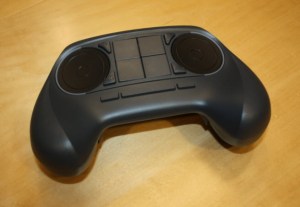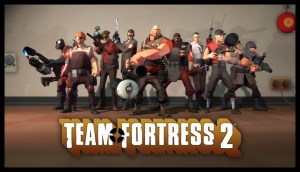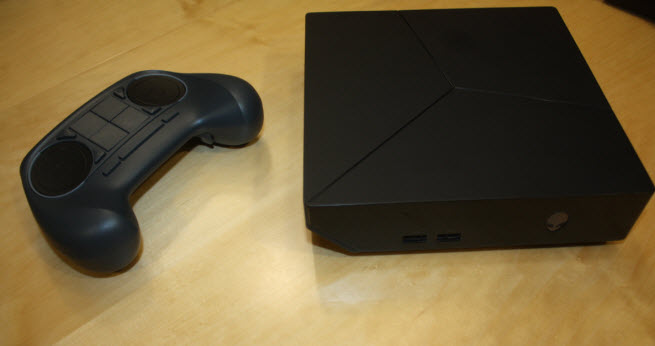Dell’s Alienware division announced this evening that it will build a Steam Machine for gamers, so they can play computer games in the living room. The project is part of a year-long collaboration with Valve, the architect of the Steam alternative to Windows PC gaming.
The collaboration between Valve and Dell shows just how much Microsoft has lost its grip on the PC business as its once-staunch ally Dell now openly teams up with Valve, which is trying to position a new Linux-based game ecosystem in the living room in a full rebellion against what it perceives as Microsoft’s closed approach to Windows games. And Valve is formidable as it has 65 million customers using its Steam digital-distribution gaming service.
The companies made the announcement at a press conference at the Palms hotel in Las Vegas at the start of the 2014 International Consumer Electronics Show (CES), a huge tech trade show. At the event, they showed off their small form-factor machine with its newfangled controller. Alienware, the gamer PC division of Dell, is just one of the hardware partners among many showing Steam Machines at CES.
Alienware will launch its Steam Machine in the second half of the year at a price and performance that will be very competitive with other gaming machines, said Marc Diana, a business development manager at Dell’s Alienware division, in an interview with GamesBeat. He said Dell will still do other Windows machines, but this machine is special.
“The product is very console-esque in its design,” Diana said. “It is going to be a product in the living room with the Steam OS. We’ll still offer Windows on our (other) systems. In terms of what’s next for PC gaming, this is it.”
The box will use Steam OS, the Linux-based operating system that Valve is creating. And it will feature Steam’s library of games, which users can bring over from their Windows PCs, as well as a Steam Controller.
A hands-on look
Alienware showed me a mock-up of the device at an interview with the Valve team in San Francisco. The box measures 8 inches by 8 inches by 3 inches. It looks like a regular game console but is considerably smaller than either the Microsoft Xbox One or the Sony PlayStation 4, its chief competitors in the living room. The box will have an Intel central processing unit and an Nvidia graphics processing unit. Beyond that, details are scarce as is the actual price.
Diana demonstrated the kind of performance that the Steam Machine will have by showing a demo of an existing high-end Alienware PC. He wouldn’t, however, tell me the specs of that PC. The PC ran Square Enix’s Tomb Raider from 2013 and Valve’s own Portal 2 with no perceivable glitches. So the performance is quite good. But it remains to be seen what it will look like when it actually launches.
“Valve is a company that listens to its customers extremely well, and they give the customers what they ask for,” Diana said. “I would like to think that Alienware does that, too.”
Diana said that the performance will not be subpar when compared to a good PC gaming experience. The machine will not run Windows even though other rivals such as Digital Storm are expecting to launch hybrid machines with both the Steam OS and Windows.
Greg Coomer, a designer at Valve, told GamesBeat that the work with Alienware has focused on how to get Steam gamers into the living room by overcoming design challenges such as the user interface. That was how Valve came up with the Steam Controller, which is a very different kind of gamepad.
The controller is designed to help PC gamers make the switch from a mouse and keyboard to a two-handed controller. The big difference compared to a standard game controller for a console is that the Steam Controller doesn’t have dual analog sticks. It has dual trackpads, which have large, high-resolution touch surfaces where the entire surface acts as a button. I found that you could very easily run a thumb sideways on the trackpad and achieve a strafing-like effect. That’s pretty valuable for first-person shooter games.
The Steam Controller took a lot of methodical testing and iteration. Valve has taken that approach to the whole Steam Machine project, Coomer said. It has tested parts of the system by adding to the Steam digital-distribution service over time. For instance, it launched the Big Picture feature that enables Windows-based Steam games to play on your TV. It could have stopped there, but it needed to push ahead with its own controller because of the challenge of playing mouse-based games like real-time strategy games with a game controller.
“In the year we have been working with Alienware, the conversation on our side was what kind of experience would Steam gamers want in the living room, what kind of performance would Steam gamers expect, what price-performance balance our customers would find most attractive,” Coomer said.
Valve had the software expertise to build Steam and the operating system but not the hardware. After all, it has only 300 employees, and many of those are making games like titles in the Portal, Half-Life, and Left 4 Dead series.
So the two companies collaborated. Dell and Valve had already been partners since 2009, when Alienware included Valve’s Steam digital-download service on its computers.
Alienware had already tried its hand at living-room gamer PCs with the Alienware X51. That system was handicapped somewhat with the Windows operating system and the lack of an appropriate controller.
“We think that Valve has cracked the code in entering the living-room environment,” Diana said.
Why make a Steam Machine
While Microsoft has huge advantages with Windows gaming, Valve’s Steam service has grown to more than 65 million customers. Anna Sweet, a team member at Valve, said that the company is creating Steam Machines because of what it has heard from its own customers.
“They have their games, their friends, their community, and all the things they like about Steam, and it has been artificially tied to the home office with a keyboard and mouse,” Sweet said. “Having a product like a Steam Machine and putting it in the living room, having it connected, with all those things they like on the couch, that’s what we’ve heard over and over.”
It will be interesting to see what price the Steam Machines will set at. Presumably, Valve will charge a lower fee for the Steam OS than Microsoft does for Windows, so that will make a difference.
Diana said it’s important that players will have access to a whole library of Steam games that they already own. Diana also said it isn’t acceptable to put a 1,200-watt PC-gaming-enthusiast machine in the living room. That means Alienware has to come up with something different to reach gamers in that space.
Coomer said, “We think about Steam Machines as an extension to Steam. We’ve been shipping updates for years. We are used to providing value that way. Our customers have asked us for things. This is another thing they are asking for. They are tired of giving up their friends lists when they move from one room in the house to another.”
When asked about overcoming all of the barriers and doubts to launching such a machine to compete with the game consoles, Coomer said, “If we were starting from zero, all of that conventional wisdom would absolutely apply. Being able to start with a base of 65 million happy customers is an advantage. That gives us a giant springboard.”
Valve also had the advantage of having lots of unique games from indie developers on Steam. A lot of cool titles on Steam never make it to the consoles.
Friction with Microsoft
Coomer also acknowledged that Microsoft’s moves to close off its platform also made a difference. Gabe Newell, CEO of Valve, said that Microsoft’s move to shift focus on the PC to its own Windows Store was a “catastrophe” back in mid-2012.
Coomer said, “We just see everything like that. That is one thing in a big category of moves that made us nervous about having more friction between us and the customers.”
Other problems included the ability to update games. With Team Fortress 2, Valve has created more than 400 updates for the multiplayer shooter on the Steam service. In the same span of time, customers of Team Fortress 2 on Microsoft’s platform have only seen two updates.
“We hate that,” Coomer said. “Any trajectory headed in that direction sets off alarm bells. It doesn’t mean we want our customers to abandon Windows. Our nervousness isn’t causing us to get our customers to do a mass migration. Mainly, this is about finding a path to the living room that is unencumbered and free of those sources of friction.”
Asked if Valve’s box was open, Coomer said, “Openness is a conversation all to its own.” Valve has joined the Linux Foundation, but that doesn’t necessarily show how open it will be. Coomer said, “It’s fine with us if you want to put Android on the box.”
Diana said, “If there was one word that drove this project, it is ‘open.'”
One example is that any computer maker that wants to ship a Steam Machine will be able to do so with very little handholding from Valve, Coomer said.
Just how big is this?
As for the size of the effort, Valve started small, and the project grew as the company realized it had to do more of the work, like building an operating system. It reduced the scope of the undertaking by shipping a lot of updates to Steam.
Sweet said, “We’ve gotten this far by listening to what customers are asking for. After this ships, we’ll continue to listen to them.”
It seemed like Valve has taken forever to get this far. Coomer said a lot of work went into the operating system, building the controller, and other details.
“We would have liked to have shipped this a couple of years ago,” Coomer said. “We can’t quite turn on a dime. But we are also focused on putting value in this package. It’s finally coming together.”
Valve has been doing “parallel work” in research on virtual reality games, Coomer said. That isn’t connected to this effort to make Steam Machines or show new boxes at CES, Coomer said.
As for being competitive with the consoles, Diana said, “We will be highly competitive. This is a machine that will be available in many parts around the globe.”
VentureBeat's mission is to be a digital town square for technical decision-makers to gain knowledge about transformative enterprise technology and transact. Learn More















![Reblog this post [with Zemanta]](http://img.zemanta.com/reblog_e.png?x-id=aa787f82-9bcb-4c46-949e-b1f13094a3e8)
